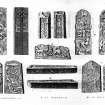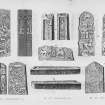Pricing Change
New pricing for orders of material from this site will come into place shortly. Charges for supply of digital images, digitisation on demand, prints and licensing will be altered.
Upcoming Maintenance
Please be advised that this website will undergo scheduled maintenance on the following dates:
Thursday, 9 January: 11:00 AM - 3:00 PM
Thursday, 23 January: 11:00 AM - 3:00 PM
Thursday, 30 January: 11:00 AM - 3:00 PM
During these times, some functionality such as image purchasing may be temporarily unavailable. We apologise for any inconvenience this may cause.
Meigle
Cross Slab (Pictish), Pictish Symbol Stone (Pictish)
Site Name Meigle
Classification Cross Slab (Pictish), Pictish Symbol Stone (Pictish)
Alternative Name(s) Meigle Museum; Meigle Stones; Meigle No.2; Queen Vanora's Stone
Canmore ID 30849
Site Number NO24SE 25.02
NGR NO 2872 4459
Datum OSGB36 - NGR
Permalink http://canmore.org.uk/site/30849
- Council Perth And Kinross
- Parish Meigle
- Former Region Tayside
- Former District Perth And Kinross
- Former County Perthshire
Meigle 2, Perthshire, cross-slab
Measurements: H 2.55m, W 1.00m, D 0.15m
Stone type: sandstone
Place of discovery: NO 2872 4463
Present location: Meigle Museum.
Evidence for discovery: in the mid nineteenth century, the stone stood on the east side of the original gateway into the churchyard, to the north of the church. Beside it was a small mound known locally as Vanora’s grave.
Present condition: there is overall weathering, which is severe at the foot of face A.
Description
In its proportions and ornament, this is a truly majestic monument. With parallel sides and a rounded top, both broad faces are heavily carved in relief, and two short tenons project from narrow faces B and D. These are likely to have been functional, whereas the remains of a projection at the apex of the slab was probably ornamental.
Within a plain flat-band border, face A bears a massive ringed cross, the head of which is embellished with bosses: four on each arm, eight on the ring and eight surrounded a single larger boss in the centre of the cross-head. Many of them show traces of encircling serpents. The arm-terminals and the central panel are square, creating double-square armpits, and the surface of the entire head, where not covered by bosses, is carved with diagonal key pattern. The shaft of the cross is twice the width of the arms, and it is outlined by a roll moulding and has large spirals at each corner. Within the shaft are three registers of zoomorphic ornament, though the lowest is too worn to make out its details. At the top two confronted quadrupeds stand chest to chest and nose to nose, with the spaces above their backs filled by contorted creatures hanging on to their necks. The spaces under their bodies are filled by two more creatures. The middle register has another pair of confronted quadrupeds separated by two entwined reptiles. More animals flank the shaft, all apparently desperate to climb to the top. On the right an elongated hound hangs by the neck from the corner spiral, another hound is scrabbling upwards with the foot of the upper hound in its jaws and a third creature hanging from its hind leg. To the left of the shaft, a human figure kneels on the corner spiral, holding the arm of another figure climbing up from below. Below again, two or three animals are also trying to climb upwards.
Face C presented the sculptor with one great panel to carve, and he has filled it with distinct scenes one above the other. At the top a solitary pre-eminent warrior rides his horse briskly to the left, a pair of hounds before him and in the background an angel. Below another solitary rider is preceded by his attendant troops riding three abreast, again to the left. The central scene shows a frontal figure in full robes is beset on either side by two pairs of clawing lions. Below again is a centaur with an axe in either hand and trailing branches as he trots to the right. At the bottom of the panel a horned animal tries to pull away from another animal that has its jaws clamped round its snout, while tucked into the background behind them is a human figure carrying a club over one shoulder.
Date range: ninth century.
References: ECMS pt 3, 296-7; RCAHMS 1994, 98.
Desk-based information compiled by A Ritchie 2018
NO24SE 25.02 2872 4459.
This imposing cross-slab, which formerly stood on the left-hand side of the gateway into the burial-ground (NO24SE 33.01), measures 2.55m in height, 1m in width and 0.15m in thickness. Erected in its original socket-stone, a sandstone block some 2.05m by 0.95m and at least 0.22m in thickness, this slab dominates the collection. The ringed cross-potent is now worn, as is the decoration on either side of the shaft. The ring and the cross-head are ornamented with raised bosses, four in each arm and a rather larger boss in an encircling rosette of eight at the centre. The surface of the cross and the ring have been decorated with key-pattern. On the shaft, which has projecting volutes at top and base, there are three pairs of facing beasts, and on the left of the shaft there appear to be three figures, the uppermost kneeling in the angle of the cross and pulling up his companion by the wrist, while on the right side there are three beasts, the uppermost with its chin resting on the voluted angle of the cross-shaft. The back of the shaft contains four images: the uppermost is a hunting scene with two single horsemen, three others riding abreast, a pair of hounds and an angel. Below this there is a representation of Daniel in the den of lions, the prophet wearing a flaring robe, with two lions and a smaller animal, a lion-cub, perhaps, on each side. Below Daniel there is a centaur with an axe in each hand and a leafy branch under his arm; at the bottom of this face of the slab, a man with a club over his shoulder watches a dragon biting the nose of a horned beast. The top and both edges of the slab bear tenon-like projections of unknown purpose.
Information from RCAHMS (JNGR) 1990.
Publication Account (1964)
No. 2 The small projections on sides and top are of unknown purpose. The 'ring of glory' contains an equal-armed cross: both are embellished with raised bosses, possibly inspired by the rivet heads of metal work. The surfaces of cross and wheel have been covered with a diagonal key pattern. The long shaft has three pairs of facing beasts. On the left of the shaft are three climbing figures, the top kneels and hauls that below it. On the right of the shaft, are three beasts with large heads and long coiled bodies.
The central subject on the other side is Daniel in the Lion's Den, symbolising the delivery of the faithful from the power of evil. Daniel's arms are raised in the 'orans' or ancient attitude of prayer as he stands appealingly in the midst of fierce lions.
Above Daniel is an equestrian group. The top figure is cloaked, bearded, carries a spear and is girt with a sword. He sits upon a saddle-cloth; his horse is bridled. In front of him are two hounds with an angel above, probably representing the Soul. Beneath him a cavalcade is suggested by three riders abreast, followed by a single rider.
Below Daniel, a centaur with two axes and a branch of a tree. At the bottom, a man with a club, and a dragon grasping a horned beast by the nose.
S Cruden 1964.


















































































































